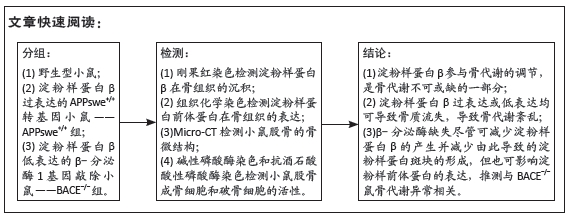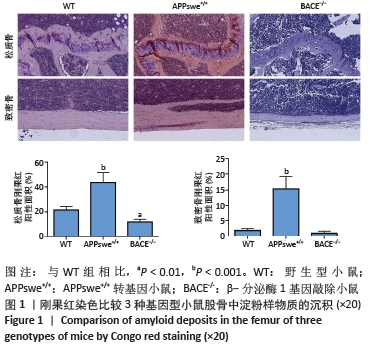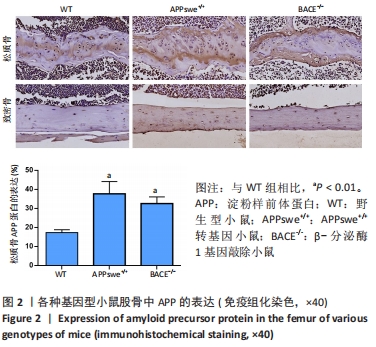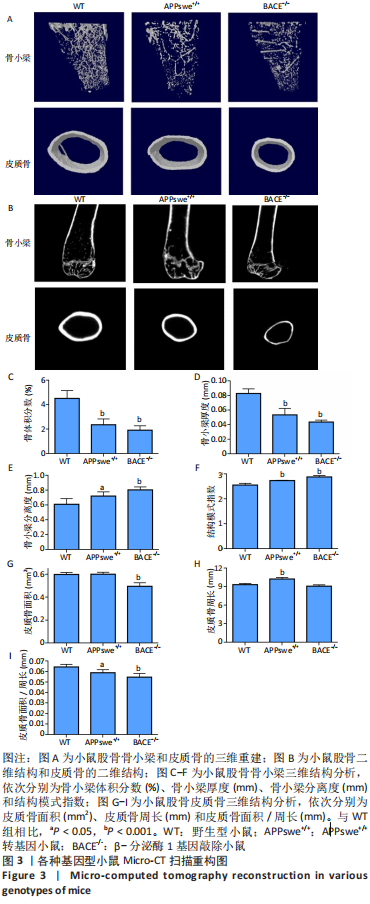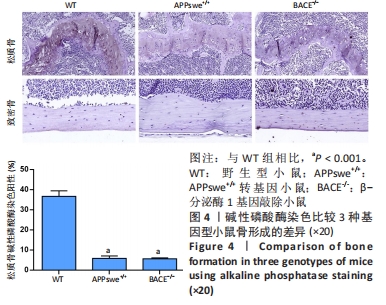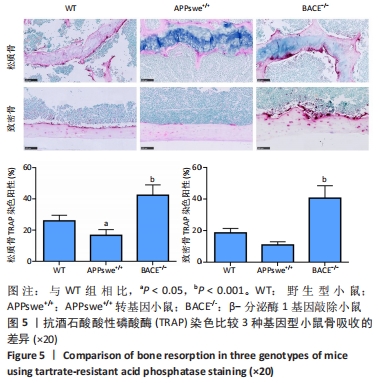[1] 孙红婷,宋艳荣. 楮实子提取物对APP /PS1小鼠学习记忆能力及对PI3K-C R EB-XBP1信号通路的影响[J]. 中国免疫学杂志,2019, 35(24):3021-3026.
[2] PENNEY J, RALVENIUS WT, TSAI L. Modeling Alzheimer’s disease with iPSC-derived brain cells. Mol Psychiatry. 2020;25(1):148-167.
[3] DENGLER-CRISH CM, ELEFTERIOU F. Shared mechanisms: osteoporosis and Alzheimer’s disease. 2019:1317-1318.
[4] CUI S, XIONG F, HONG Y, et al. APPswe/Aβ regulation of osteoclast activation and RAGE expression in an age-dependent manner. Bone Miner Res. 2011;26(5):1084-1098.
[5] XIA W, JUNG J, SHUN C, et al. Swedish mutant APP suppresses osteoblast differentiation and causes osteoporotic deficit, which are ameliorated by N-acetyl-L-cysteine. J Bone Miner Res. 2013;28(10): 2122-2135.
[6] MCLEOD J, CURTIS N, LEWIS HD, et al. γ‐Secretase‐dependent cleavage of amyloid precursor protein regulates osteoblast behavior. FASEB J. 2009;23(9): 2942-2955.
[7] LI S, LIU B, ZHANG L, et al. Amyloid beta peptide is elevated in osteoporotic bone tissues and enhances osteoclast function. Bone. 2014;61:164-175.
[8] IMBIMBO BP, WATLING M. Investigational BACE inhibitors for the treatment of Alzheimer’s disease. Expert Opin Investig Drugs. 2019; 28(11):967-975.
[9] TIWARI S, ATLURI V, KAUSHIK A, et al. Alzheimer’s disease: pathogenesis, diagnostics, and therapeutics. Int J Nanomedicine. 2019; 14:5541-5554.
[10] BERA S, CAMBLOR-PERUJO S, CALLEJA BE, et al. AP-2 reduces amyloidogenesis by promoting BACE1 trafficking and degradation in neurons. EMBO Rep. 2020;21(6):e47954.
[11] 邱伟, 连星烨. 唑来膦酸干预老年骨质疏松性股骨转子间骨折髋关节置换后患者骨密度、骨代谢标志物的2年随访[J]. 中国组织工程研究,2021,25(33):5265-5272.
[12] MACÍAS I, ALCORTA-SEVILLANO N, RODRÍGUEZ CI, et al. Osteoporosis and the Potential of Cell-Based Therapeutic Strategies. Int J Mol Sci. 2020;21(5):1653.
[13] ALZHEIMER’S ASSOCIATION. 2015 Alzheimer’s disease facts and figures. Alzheimers Dement. 2015;11(3):332-384.
[14] DOWNEY CL, YOUNG A, BURTON EF, et al. Dementia and osteoporosis in a geriatric population: Is there a common link? World J Orthop. 2017;8(5):412.
[15] STAPLEDON CJM, STAMENKOV R, CAPPAI R, et al. Relationships between the Bone Expression of Alzheimer’s Disease-Related Genes, Bone Remodelling Genes and Cortical Bone Structure in Neck of Femur Fracture. Calcif Tissue Int. 2021;108(5):610-621.
[16] NGUYEN PH, RAMAMOORTHY A, SAHOO BR, et al. Amyloid Oligomers: A Joint Experimental/Computational Perspective on Alzheimer’s Disease, Parkinson’s Disease, Type II Diabetes, and Amyotrophic Lateral Sclerosis. Chem Rev. 2021;121(4):2545-2647.
[17] OTZEN D, RIEK R. Functional Amyloids. 2019:11.
[18] ROHER AE, ESH CL, KOKJOHN TA, et al. Amyloid beta peptides in human plasma and tissues and their significance for Alzheimer’s disease. Alzheimers Dement. 2009;5(1):18-29.
[19] YANG B, LI S, CHEN Z, et al. Amyloid β peptide promotes bone formation by regulating Wnt/β‐catenin signaling and the OPG/RANKL/RANK system. FASEB J. 2020;34(3):3583-3593.
[20] 李苗苗, 罗炯, 张庭然, 等. 骨质代谢与运动训练:骨重塑与骨细胞增殖[J]. 中国组织工程研究,2019,23(34):5544-5549.
[21] LIU H, LUO T, TAN J, et al. ‘Osteoimmunology’ Offers New Perspectives for the Treatment of Pathological Bone Loss. Curr Pharm Des. 2017; 23(41):6272-6278.
[22] NIE R, WU Z, NI J, et al. Porphyromonas gingivalis Infection Induces Amyloid-beta Accumulation in Monocytes/Macrophages. J Alzheimers Dis. 2019;72(2):479-494.
[23] PARK EK, JUNG HS, YANG HI, et al. Optimized THP-1 differentiation is required for the detection of responses to weak stimuli. Inflamm Res. 2007;56(1):45-50.
[24] LEE JW, NAM H, KIM LE, et al. TLR4 (toll-like receptor 4) activation suppresses autophagy through inhibition of FOXO3 and impairs phagocytic capacity of microglia. Autophagy. 2019;15(5):753-770.
[25] JIN HK, BAE JS, FURUYA S, et al. Amyloid beta-derived neuroplasticity in bone marrow-derived mesenchymal stem cells is mediated by NPY and 5-HT2B receptors via ERK1/2 signalling pathways. Cell Prolif. 2009;42(5):571-586.
[26] KORONYO-HAMAOUI M, SHEYN J, HAYDEN EY, et al. Peripherally derived angiotensin converting enzyme-enhanced macrophages alleviate Alzheimer-related disease. Brain. 2020;143(1):336-358.
[27] SHIN BK, KANG S, KIM DS, et al. Intermittent fasting protects against the deterioration of cognitive function, energy metabolism and dyslipidemia in Alzheimer’s disease-induced estrogen deficient rats. Exp Biol Med (Maywood). 2018;243(4):334-343.
[28] SIVAJI K, KANNAN RR, NANDHAGOPAL S, et al. Exogenous human beta amyloid peptide interferes osteogenesis through Sox9a in embryonic zebrafish. Mol Biol Rep. 2019;46(5):4975-4984.
[29] DANIELS MJ, RIVERS-AUTY J, SCHILLING T, et al. Fenamate NSAIDs inhibit the NLRP3 inflammasome and protect against Alzheimer’s disease in rodent models. Nat Commun. 2016;7:12504.
[30] WANG TH, JIANG Y, XIAO LP. Expression of amyloid beta-protein in bone tissue of APP/PS1 transgenic mouse. Zhonghua Yi Xue Za Zhi. 2013;93(1):65-68.
[31] SPÄNI C, SUTER T, DERUNGS R, et al. Reduced beta-amyloid pathology in an APP transgenic mouse model of Alzheimer’s disease lacking functional B and T cells. Acta Neuropathol Commun. 2015;3:71.
[32] CRUZ E, KUMAR S, YUAN L, et al. Intracellular amyloid beta expression leads to dysregulation of the mitogen-activated protein kinase and bone morphogenetic protein-2 signaling axis. PLoS One. 2018;13(2): e0191696.
|
